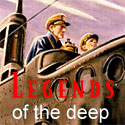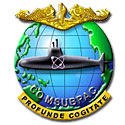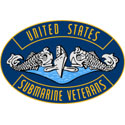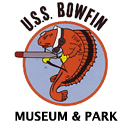Here is the second installment of Chuck Thompson's assessment of the Russian Iskra Team video. He begins with an interpretation of Wahoo's loss based on known facts and review of the wreck footage. He then follows with a detailed description of the footage itself.
SINKING SCENARIO
Based on the examination of the available video of the wreck of the USS Wahoo, the following sequence of events is proposed.
Wahoo was in the process of transiting La Perouse Strait when she was detected by a Japanese aircraft looking for a submarine exiting the Sea of Japan. Wahoo was at periscope depth and had both scopes raise. During the first aerial attack, at least one of the bombs or depth charges scored a nearly direct hit to starboard at near main deck level in the area of the Control Room/After Battery Room bulkhead (frame 59). The result of this attack was severe damage to the main ballast tank 2C and fuel ballast tank 3A (hence the oil observed), and the conning tower fairwater. The pressure hull was ruptured on the starboard side near the junction of the Control Room/After Battery bulkhead, and possibly the conning tower (if not ruptured, the conning tower would have flooded through open lower conning tower hatch). The boat would have rolled severely to port, and experienced severe hull flexures which seem to travel along the hull and back again.
All personnel in the after battery room, control room and conning tower would have been incapacitated, and by the time they could recover, these spaces would have been flooded except for small air pockets and the top of the conning tower. The fact that the stern planes and probably the bow planes appear straight and level indicates that no attempt was made to surface. If the door to the forward battery room and forward engine room were open, they may also have flooded. It is probable that damage beyond these spaces was extensive, as there is no indication that any attempt was made by the surviving crew to escape from the forward or after spaces. Subsequent attacks and depth charging may have prevented the crew from trying to escape, and resulted in superficial superstructure damage, resulting in the superstructure damage visible today.
VIDEO SEQUENCE
(all times are from the video player, with time 0 at the beginning of the video)
The video begins with a brief Wahoo history, and information on the Russian dive team.
Eight (8) minutes into the tape, video of the wreck begins. The diver approaches the wreck from the starboard side, just aft of the conning tower fairwater (CTF), and the wreck is silhouetted. As the image comes into focus, extensive damage is apparent amidships as a break in the CTF silhouette and a dark area of the hull below the break in the CTF, extending downward around the hull.
At 08:10, as the diver approaches the wreck, a large chunk of debris is visible on the bottom, alongside the hull, immediately forward of the damaged area below the bridge. No detail is visible. The approach to Wahoo appears to be more zooming in than the diver getting closer to the hull, as detail does not improve.
At 08:25 image fades into swimming alongside the hull, mid level on ballast tanks, location unknown, possibly starboard side moving aft. The bilge keel is visible. No damage is visible.
At 08:36 film shifts to a different location, still swimming along the hull slightly higher. We are led by following sequence to believe this is starboard side moving aft. At the top of the ballast tanks, vertical superstructure is visible, with Government type limber holes. No damage is visible.
At 08:53 video shifts again, this time swimming along the starboard side, approaching the stern. The starboard propeller and shaft are visible. Footage continues around the stern, showing starboard (first) then both stern diving planes, and the rudder. Both planes are close to straight and level. The rudder is amidships. No damage is visible.
At 09:46 the diver is moving forward, and swims under the port stern plane and past the propeller. No damage is visible.
At 10:09 the diver continues to swim forward along the port side. Government type limber holes are visible. The hull appears to be in good shape, with many areas’s clear of marine growth. This is apparently the up current side, so there is less marine growth. No visible damage.
At 01:26 the port aft engine exhaust hole comes into view.
At 10:33 the port forward engine exhaust hole comes into view. Also the first of the “missing” superstructure is visible forward and aft of the exhaust. This appears to be corrosion damage, as the surrounding superstructure and supports do not appear damaged.
At 10:42, shift to new film sequence. Diver aft of the CTF, moving forward along the port side, at the top of the ballast tanks, looking athwartship through the superstructure. Most of the vertical superstructure is missing, apparently from corrosion. The supports for the superstructure are in place and not distorted. The top of the pressure hull is frequently visible, with external hull reinforcements (ribs), along with other hull components/piping located below the aft deck. Sometimes you can see all the way through to the starboard side.
At 11:23 an intact section of vertical superstructure, with Government style limber hole, is visible. Superstructure fore and aft is missing, again because of corrosion?
At 11:47 the CTF comes into view from port aft, at deck level. The aft (tapered) end of the superstructure is visible, with side plating rusted out.
At 11:52 fade into diver swimming forward from aft of the CTF. Diver is to starboard and just above the level of the cigarette deck. As the diver approaches the CTF, the extensive damage becomes visible. The diver swims over the aft end of the cigarette deck, and the missing area becomes clear, although details are difficult to distinguish. It is apparent that much of the cigarette deck superstructure, as well as port and starboard deck are missing.
At 11:58 shift back to footage we left at 11:51, swimming forward along the port side just below deck level, with CTF coming into view. Aft end of CTF is in the foreground, bridge and sheers in background. Damage difficult to see.
At 12:02 shift to close up of the free standing aft end of the CTF. Plating is rusted out, although support structure is in place, and does not appear damaged.
At 12:05 camera pans to the left, and is looking at deck level, up the port side, alongside the CTF (to right). The missing port deck and center section of CTF is clearly visible. The forward edge of the missing deck appears to be a fairly sharp break, with teak decking visible. As the camera moves forward, the vertical CTF superstructure, including supports, is completely missing. The forward ballast tanks are not visible.
At 12:12 the camera is approaching the missing area of the CTF. Before any details of the damage can become clear, the image fades out.
At 12:14 video moves back to same sequence ended at 11:57, looking forward from above aft of the CTF. The sharp, clean break of the bridge deck (fwd part of cigarette deck) is visible. The D/F loop is in the center of the photo. Radio antenna supports, port & starboard are visible. A large piece of unknown debris sticks out to starboard at the level of the lookout platforms.
At 12:17 the bridge structure (from aft looking fwd) is visible, the lower sheers rising in the center of the superstructure from the cigarette deck to the lookout platforms. Immediately to the right of the lower sheers appear to be several large areas of marine growth blocking access to starboard. This does not appear to be ready service lockers.
At 12:18 video fades to looking forward along the port side. CTF fills right half of the photo. We are apparently immediately above the main damaged area, to port. The broken end of the D/F loop shaft is visible to the right. The camera pans to the right until both the port and starboard vertical sides of the CTF are visible. The camera is pointed directly at the aft end of the conning tower (could this be the cigarette deck pushed down and forward, covering the aft end of the conning tower?). The forward edge of the broken deck to port of the CTF is visible at left. While this is a good shot of the damaged area aft of the CTF, details are hard to distinguish.
At 12:20 what may be the bottom edge of the conning tower (or the aft end of the cigarette deck blown downward) is visible at the bottom of the picture. This appears as a sharp, horizontal but ragged edge. If this is the conning tower, it should be rounded. The absence of the starboard decking and superstructure is obvious – it is completely missing.
At 12:22 the camera is looking down and to starboard, right into the damaged area. It is obvious that all decking and supports are missing. The area shown would have been in the area of the starboard CTF manway. The damaged area visible must include the pressure hull.
At 12:25 the video shifts to looking at the primary area of damage. The video is looking aft, just forward from the main damage area, at the main deck level (stbd side), looking along the fore/aft axis of the fairwater. The location of this video is not discernible until the end of this sequence (12:43), when the ragged edge at the end of the conning tower (identifiable at 12:20), comes into view, at the lower right side of the video (this took me a very long time to understand). Close examination of this sequence does not answer any questions concerning loss, as the pressure hull is visible below the array of damaged structure,
At 12:32 a hand illustration of the damaged area, from starboard, comes into the picture, obscuring much of the picture. This is unfortunate as there is much to be seen. Although the hand illustration is a broadside view from starboard, nothing in the video can be correlated as being from that area.
12:35 A note at the bottom of the video states that except for the rupture, the hull looks almost whole.
12:39 Same ragged edge visible at 12:20 comes into view, lower right hand corner of the picture, as the view shifts from aft to port.
At 12:43 the hand drawing fades away. It is not possible to identify anything in the photo, although the pressure hull and port deck edge must be there.
At 12:44 different video of the damaged area, this time looking from starboard to port, with the CTF superstructure at right and the missing deck superstructure at center. The forward and aft ends of the port deck are visible, the area in between missing due to damage. The camera backs up, and the ragged bottom edge of the conning tower (?) and the broken edge of the D/F loop shaft are visible. (the footage at this point is actually being run backwards, as the debris in the water is moving backwards, and the fish are swimming backwards.) The structure across the bottom of the picture must be the pressure hull.
At 12:53 camera shift to the same footage that faded out at 12:22. The camera is looking at the area under the cigarette deck with the ragged bottom of the conning tower visible across the bottom (same footage as before, even the same fish). The camera pans to port and up.
And by 12:58 we are looking at the port side of the CTF, forward of the damaged area, swimming forward.
Still images captured from the video are available on Legends of the Deep.
Part III coming soon...
This Sounds Like It's From The Onion...
12 years ago








0 comments:
Post a Comment